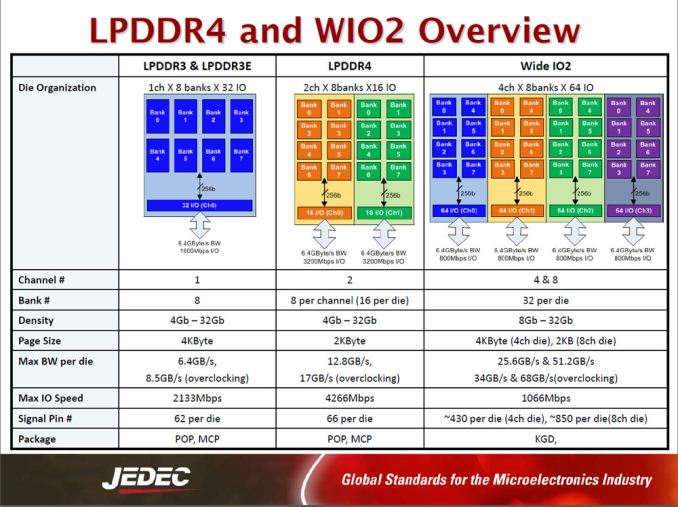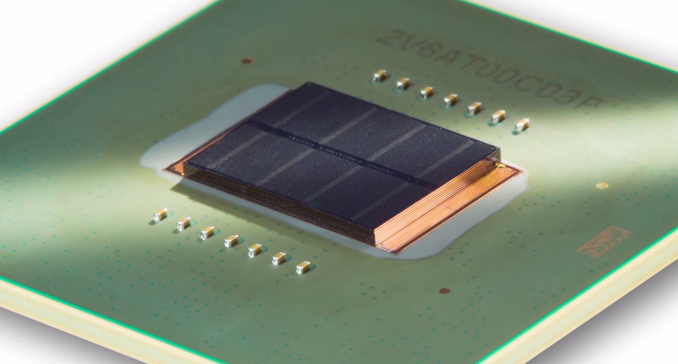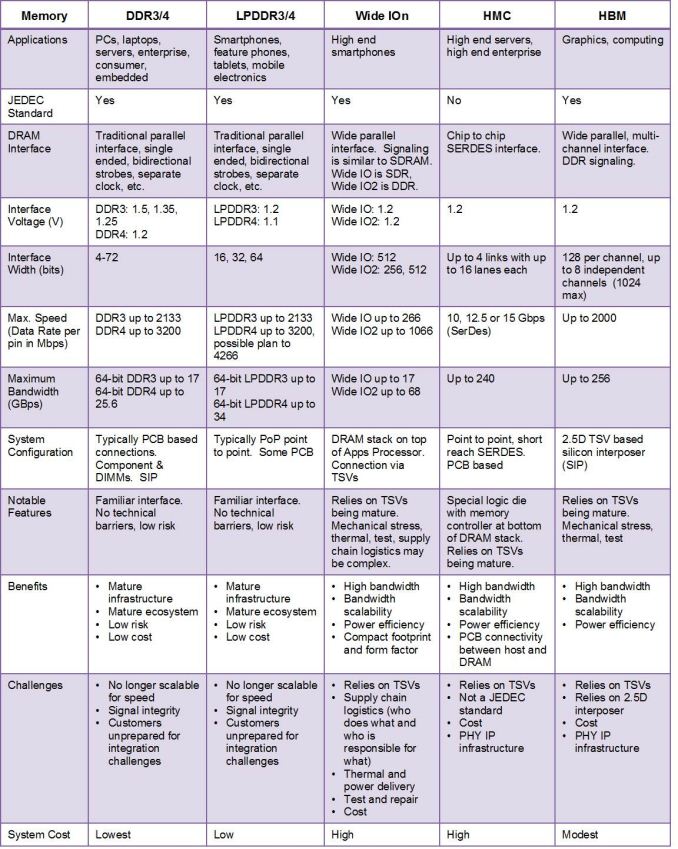DDR4 Haswell-E Scaling Review: 2133 to 3200 with G.Skill, Corsair, ADATA and Crucial
by Ian Cutress on February 5, 2015 10:10 AM ESTThe Future of DDR4
DDR4 was first launch in the enthusiast space for several reasons. On the server side, any opportunity to use lower power and drive cooling costs down is a positive, so aiming at Xeons and high-end consumer platforms was priority number one. Any of the big players in the datacenter space most likely had hardware in and running for several months before the consumer arms got hold of it. Being such a new element in the twisting dynamic of memory, the modules command a premium and the big purchasers got first pick. The downside of when that shifts to consumer where budgets are tighter and some of the intended benefits of DDR4 are not that important, such as lower power, it causes problems. When we first launched our Haswell-E piece, the cost of a 4x4GB kit of JEDEC DRAM for even a basic eight-core system was over $250, and not much has changed since. Memory companies have lower stock levels, driving up the cost, and will only make and sell more if people start buying them. At this point, Haswell-E and DDR4 is really restricted to early adopters or those with a professional requirement to go down this route.
DDR4 will start to get interesting when we see it in the mainstream consumer level. This means when regular Core i3/i5 desktops come into being, and eventually SO-DIMM variants in notebooks. The big question, as always, is when. If you believe the leaks, all arrows point towards a launch with Skylake on the Intel side, after Broadwell. Most analysts are also in this category, with the question being on how long the Broadwell platform on desktops is to last. The 14nm process node had plenty of issues, meaning that Q1 2015 is when we have started to see more Core-M (Broadwell-Y) products in notebooks and the launch of Broadwell-U, aiming at the AIO and mini-PC (such as the NUC and BRIX) market as well as laptops. This staggered launch would suggest that Broadwell on desktops should be due in the next few months, but there is no official indication as to when Skylake will hit the market, and in what form first. As always, Intel does not comment on unreleased product when asked.
On the AMD side of the equation, despite talks of a Kaveri refresh popping up in our forums and discussions about Carrizo focusing only on the sub-45W market with Excavator cores, we look to the talk surrounding Zen, K12 and everything that points to AMD’s architecture refresh with Jim Keller at the helm sometime around 2016. In a recent round table talk, Jim Keller described Zen as scaling from tablet to desktop but also probing servers. One would hope (as well as predict and imagine) that AMD is aiming for DDR4 with the platform. It makes sense to approach the memory subsystem of the new architecture from this angle, although for any official confirmation we might have to wait a few months at the earliest when AMD start releasing more information.
When DDR4 comes to desktop we will start to see a shift in the proportions of the market share that both DDR4 and DDR3 will get. The bulk memory market for desktop designs and mini-PCs will be a key demographic which will shift more to an equal DDR3-DDR4 stage and we can hope to achieve price parity before then. If we are to see mainstream DDR4 adoption, the bulk markets have to be interested in the performance of the platforms that require DDR4 specifically but also remain price competitive. It essentially means that companies like G.Skill that rely on DRAM sales for the bulk of their revenue have to make predictions on the performance of platforms like Skylake in order to tell their investors how quick DDR4 will take the market. It could be the difference between 10% and 33% adoption by the end of 2015.
One of the questions that sometimes appears with DDR4 is ‘what about DDR5?’. It looks like there are no plans to consider a DDR5 version ever for a number of reasons.
Firstly, but perhaps minor, is the nature of the DRAM interface. It relies on a parallel connection and if other standards are indicative of direction, it should probably be upgraded to a serial connection, similarly as how PCI/PCI Express and PATA/SATA has evolved in order to increase throughput while at the same time decreasing pin counts and being easier to design for the same bandwidth.
Secondly, and more importantly, are the other memory standards currently being explored in the research labs. Rather than attempt to copy verbatim a piece from ExtremeTech, I’ll summarize it here. The three standards of interest, whilst mostly mobile focused, are:
Wide I/O 2: Designed to be placed on top of processors directly, abusing a larger number of I/O pins by TSVs, keeping frequencies down in order to reduce heat generation. This has benefits in industries where space is at a premium, saving some PCB area in exchange for processor Z-height.
Hybrid Memory Cube (HMC): Similar to current monolithic DRAM dies but using a stacked slice over a logic base, allowing for much higher density and much higher bandwidth within a single module. This also increases energy efficiency, but introduces higher cost and requires higher power consumption per module.
High Bandwidth Memory (HBM): This is almost a combination of the two above, specifically aimed more at graphics by offering multiple DRAM dies stacked on or near the memory controller to increase density and bandwidth. It is more described as a specialized implementation of Wide I/O 2, but should afford up to a 256GB/s bandwidth on a 128-bit bus with 4-8 stacks on a single interface.
Image from ExtremeTech
Moving some of the memory power consumption onto the processor directly has thermal issues to consider, which means that memory bandwidth/cost might be improved at the expense of operating frequencies. Adding packages onto the processor also introduces a heavy element of cost, which might leave these specialist technologies to the super-early adopters to begin with.
Given the time from DDR4 being considered to it actually entering the desktop market, we can safely say that DDR4 will become the standard memory option over the next four years, just as DDR3 is right now. Beyond DDR4 is harder to predict, and depends on how Intel/AMD want to approach a solution that offers higher memory bandwidth, depending at what cost. Both companies will be looking at how their integrated graphics are performing, as that will ultimately be the best beneficiary to the design. AMD has some leverage in the discrete GPU space and will be able to transfer any knowledge used over to the CPU side, but Intel has a big wallet. Both Intel and AMD has experimented with eDRAM/SRAM as extra level caches with Crystal Well and PS4/XBone, which puts less stress on the external memory demands when it comes to processor graphics, which leads me to the prediction that DDR4 will be here in the market longer than DDR3 or DDR2.
If any of the major CPU/SoC manufacturers want to invest heavily in Wide I/O 2, HBM or HMC, we will have to wait. If it changes what we see on the desktop, the mini-PC or the laptop, we might have to wait even longer.













120 Comments
View All Comments
dgingeri - Thursday, February 5, 2015 - link
Really, what applications use this bandwidth now?I'm the admin of a server software test lab, and we've been forced to move to the Xeon E5 v3 platform for some of our software, and it isn't seeing any enhancement from DDR4 either. These are machines and software using 256GB of memory at a time. The steps from Xeon E5 and DDR3 1066 to E5 v2 and DDR3 1333 and then up to the E5 v3 and DDR4 2133 are showing no value whatsoever. We have a couple aspects with data dedup and throughput are processor intensive, and require a lot of memory, but the memory bandwidth doesn't show any enhancement. However, since Dell is EOLing their R720, under Intel's recommendation, we're stuck moving up to the new platform. So, it's driving up our costs with no increase in performance.
I would think that if anything would use memory bandwidth, it would be data dedup or storage software. What other apps would see any help from this?
Mr Perfect - Thursday, February 5, 2015 - link
Have you seen the reported reduction in power consumption? With 256GBs per machine, it sounds like you should be benefiting from the lower power draw(and lower cooling costs) of DDR4.Murloc - Thursday, February 5, 2015 - link
depending on the country and its energy prices, the expense to upgrade and the efficiency gains made, you may not even be able to recoup the costs, ever.From a green point of view it may be even worse due to embodied energy going to waste depending on what happens to the old server.
Mr Perfect - Friday, February 6, 2015 - link
True, but if you have to buy DDR4 machines because the DDR3 ones are out of production(like the OP), then dropping power and cooling would be a neat side bonus.And now, just because I'm curios: If the max DDR4 DIMM is 8GB, and there's 256GB per server, then that's 32 DIMMs. 32 times 1 to 2 watts less a DIMM would be 32 to 64 watts less load on the PSU. If the PSU is 80% efficient, then that should be 38.4 to 76.8 watts less at the wall per machine. Not really spectacular, but then you've also got cooling. If the AC is 80% efficient, that would be 46.08 to 92.16 watts less power to the AC. So in total, the new DDR4 server would cost you (wall draw plus AC draw) 84.48 to 168.96 watts lower load per server versus the discontinued DDR3 ones. Not very exciting if you've only got a couple of them, but I could see large server farms benefiting.
Anyone know how to work out the KWh and resulting price from electric rates?
menting - Friday, February 6, 2015 - link
100W for an hour straight = 0.1KWH. If you figure 10-20 cents per KWH, it's about 1-2 cents per hour for a 100W difference. That's comes to about $7-$14 per month in bills provided that 100W is consistent 24/7.menting - Thursday, February 5, 2015 - link
pattern recognition is one that comes to mind.Murloc - Thursday, February 5, 2015 - link
physical restraints of light speed? Isn't any minuscule parasitic capacitance way more speed limiting than that?menting - Thursday, February 5, 2015 - link
there's tons of limiting factors, with capacitance being one of those. But even if you take pains to optimize those, the one factor that nobody can get around is the speed of light.menting - Thursday, February 5, 2015 - link
i guess i should say speed of electricity in a conductive medium instead of speed of light.retrospooty - Friday, February 6, 2015 - link
Agreed if an app required high total bandwidth it would benefit.Now see if you can name a few that actually need that.